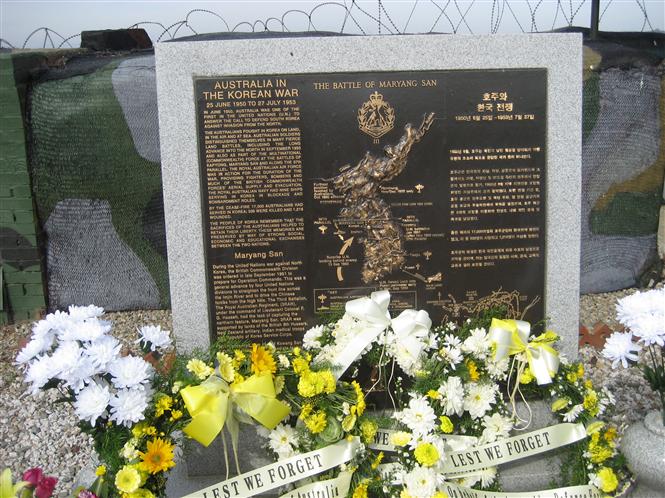Australian Army Korean War Memorial Plaque
Description
A bronze plaque mounted on a concrete plinth.
History
The war in Korea began on 25 June 1950 when North Korea, under the leadership of Kim Il Sung, invaded South Korea with the aim of unifying the country under communist rule. The North Korean People’s Army were confident that the war would be a short one having a much larger army force, far superior equipment and the support of the Soviets. Initially everything went according to plan and within three days they had captured the South Korean capital of Seoul. The North Koreans and the Soviets had, however, misjudged the American reaction to the invasion and within 24 hours of the attack President Harry S. Truman decided that the United States would intervene on the side of South Korea.
1st Battalion Royal Australian Regiment (1RAR) arrived in South Korea on 6 April 1952. The Battalion had been bought up to strength with volunteers from 2RAR and new enlistments resulting from the “K Force” recruitment campaign. Whilst not involved in any of the major battles of the Korean War, 1RAR did participate in dangerous operations involving patrolling, securing defenses, repairing minefield fences, undertaking reconnaissance of enemy positions to gather information and capturing prisoners. In March 1953, 1RAR was relieved by 2RAR and returned to Australia. The battalion returned to Korea in April 1954 and was involved in training and border patrols. In March 1956, 1RAR ceased its operations in Korea and returned to Australia.
2nd Battalion Royal Australian Regiment (2RAR), with volunteers from ‘K Force’, arrived in Korea on 17 March 1953. The Battalion was primarily deployed in patrolling the no man’s land to the north of the UN lines. This involved making small advances, defending its position, capturing prisoners, collecting intelligence and maintaining minefields and trenches. After the Armistice on 27 July 1953, 2RAR was involved in training and border patrols. It was replaced by 1RAR in April 1954 and returned to Australia.
3rd Battalion Royal Australian Regiment (3RAR) was in Japan when it was committed to the United Nations Command forces on 26 July 1950. Landing at Pusan, South Korea, on 28 September 1950 they were first deployed on 5 October in a counter-attack and advance by the UN Command. The Battalion fought numerous small engagements until the Chinese launched their First Phase Offensive on 1 November, causing a withdrawal of all UN forces. Retreating south, 3RAR conducted patrols and destroyed bridges, slowing the Chinese advance. Regrouping in January 1951, 3RAR moved north to the Kapyong Valley where they held their line whilst under continuous attack from the Chinese. For this the unit was awarded a Presidential Citation. From October 1951 until the ceasefire on 27 July 1953, 3RAR’s main activity was patrolling the no man’s land between the two opposing trench lines that ran along the 38th Parallel. Following the Armistice, 3RAR was involved in training and border patrols. The battalion returned to Australia in November 1954.
Construction Information
The plaque was arranged by Dr Ross Bastiaan.
ROK Navy transported the plaque to Korea, the Macquarie Group sponsored the installation.
Location
Observation Post (OP) Tai Poong, Korea.
OP Tai Poong is just south of the DMZ between North and South Korea.


